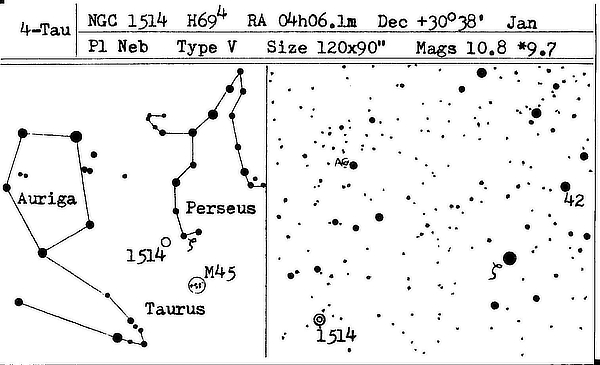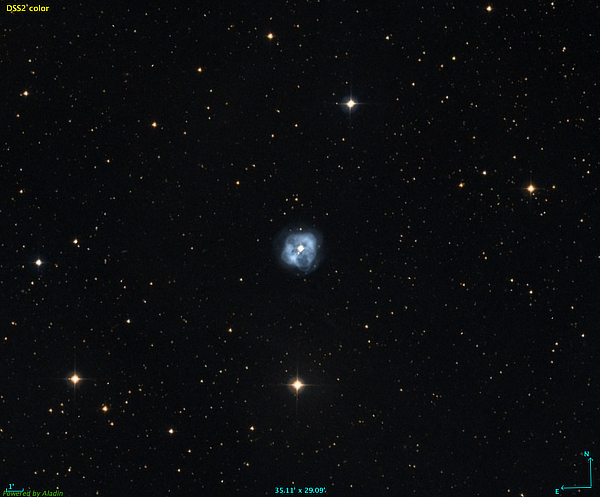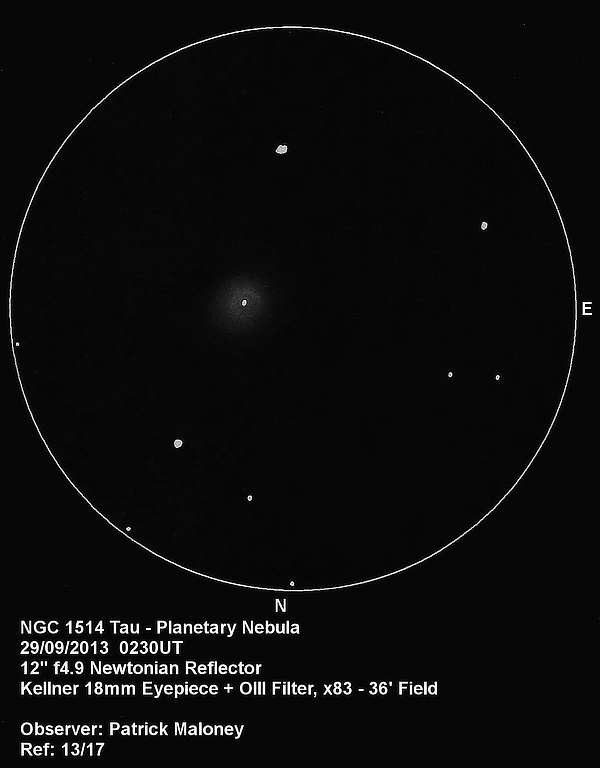NGC 1514 in Taurus
November 2024 - Nebula and Cluster of the Month
In the mid-1970s, George R Kepple produced a series of postcard-sized ‘Astro Cards’, finder charts for deep-sky objects. If I remember correctly, there were five sets, detailing the Messier Objects, the Finest NGC Objects (two sets), Double Stars and NGC Objects for Larger Telescopes.
For Christmas 1977, I was delighted to receive a set of these cards, the Finest NGC Objects (part one), which provided finder charts for 117 NGC and IC objects. I still have them. At the time, I was also a keen member of my local Astronomical Society’s Messier Objects Section, a group which consisted almost entirely of enthusiastic, though somewhat unruly, teenage boys.
Occasionally, our leader, the slightly older Ken Irving, would bring a particular object to our attention, and we would all then try to make an observation of that object. One such object was NGC 1514, a bright planetary nebula in Taurus. I was delighted to see that NGC 1514 had its own finder chart amongst my shiny new Astro Card set.

Ken had made an observation of this object with his 8” reflector, and so I set to with my 4.5” reflector. Despite my enthusiasm and my Astro Card, I have to report total failure. Despite several attempts and encouragement from Ken, I never saw it with my little 4.5” telescope.
It wasn’t until 36 years later that I actually saw the object and made an observation of it. Of course, I didn’t spend every clear night in between searching for it, in fact I probably never even looked for it again after my initial failure.

The planetary nebula was first observed by William Herschel on 30 November 1790. It was this observation that finally convinced Herschel that, even given sufficient aperture and magnification, not all ‘nebulae’ could be resolved into stars. He wrote A most singular phenomenon; an eighth-magnitude star with a faint luminous atmosphere of a circular form, about 3’ in diameter. The star is perfectly in the centre, and the atmosphere is so diluted, faint, and equal throughout, that there can be no surmise of its consisting of stars, nor can there be a doubt of the evident connection between the atmosphere and the star. Another star, not much less in brightness, and in the same field with the above, was perfectly free from any such appearance.
He placed the object in his fourth class (‘planetary nebulae’) as IV.H 69.
Perhaps surprisingly, NGC 1514 does not make it into the Herschel 400 observing list. Or maybe not so surprisingly, because this is not a particularly easy object to see. When I finally got around to looking for this object again, in September 2013, armed this time with a 12” reflector, I found that without an OIII filter, all I could see was the bright central star, which shines at magnitude 9.4. I searched carefully with averted vision, but the nebula itself eluded me, though I knew I was looking at the right star. Once the OIII filter was fitted, however, the nebula popped out of the blackness very clearly. The nebulosity is smooth and forms a bright circular disc, brightening towards the centre star and fading away at the periphery. A UHC filter will produce a very similar effect.

The Field Guide to Uranometria 2000.0 gives the diameter of the nebula as >114”, which is fairly meaningless. The Night Sky Observer’s Guide (another fine production written in part by George R Kepple) simply repeats this figure. Herschel’s estimate of 3’ could easily fall within that upper-limit-free figure but is probably a little on the large side. Visual Observations of Planetary Nebulae by Kent Wallace gives a far more precise 136 x 121”. My own estimate of the longest diameter (the nebula is very slightly elongated) is 130”.
The central star is unusually bright at magnitude 9.4 and is fairly easy to locate. The overall magnitude for the object is usually given as 10.9, but bear in mind that it is quite difficult to see and that some filtering may be necessary.
| Object | RA | Dec | Type | Magnitude |
|---|---|---|---|---|
| NGC 1514 | 04h 09m 17s | +30° 46’ 33” | Planetary nebula | 10.9 |